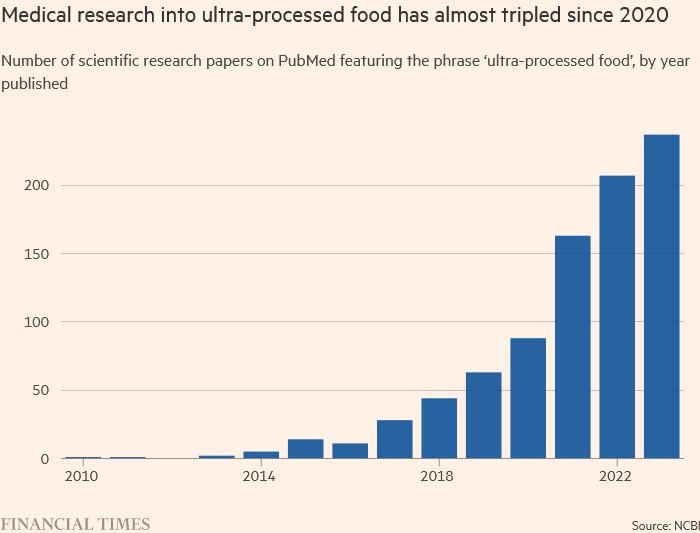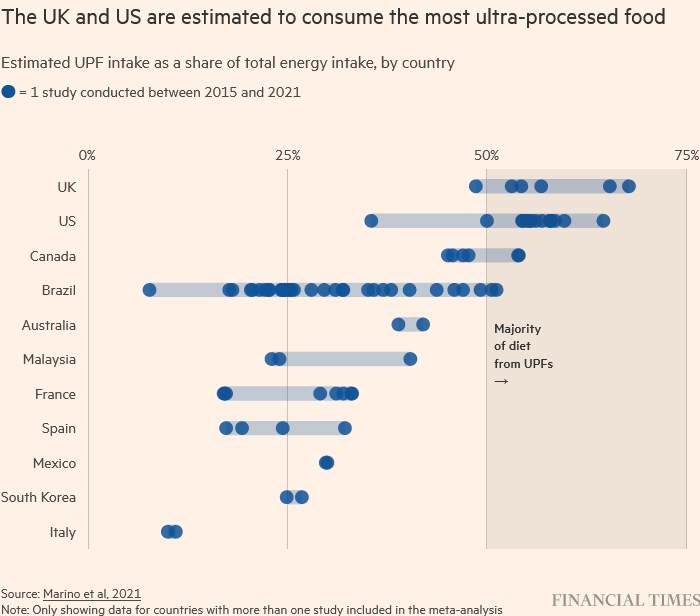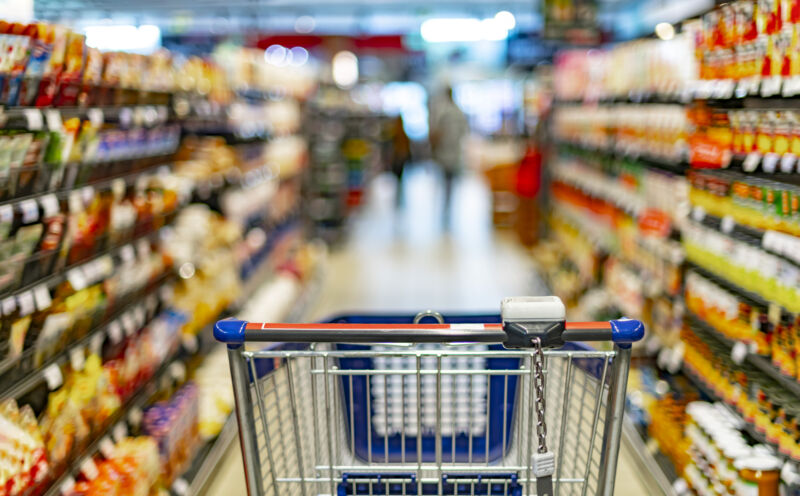Big Food is trying to dampen fears about the effects of industrially formulated substances.
When the Brazilian nutritional scientist Carlos Monteiro coined the term “ultra-processed foods” 15 years ago, he established what he calls a “new paradigm” for assessing the impact of diet on health.
Monteiro had noticed that although Brazilian households were spending less on sugar and oil, obesity rates were going up. The paradox could be explained by increased consumption of food that had undergone high levels of processing, such as the addition of preservatives and flavorings or the removal or addition of nutrients.
But health authorities and food companies resisted the link, Monteiro tells the FT. “[These are] people who spent their whole life thinking that the only link between diet and health is the nutrient content of foods ... Food is more than nutrients.”
Monteiro’s food classification system, “Nova,” assessed not only the nutritional content of foods but also the processes they undergo before reaching our plates. The system laid the groundwork for two decades of scientific research linking the consumption of UPFs to obesity, cancer, and diabetes.
Studies of UPFs show that these processes create food—from snack bars to breakfast cereals to ready meals—that encourages overeating but may leave the eater undernourished. A recipe might, for example, contain a level of carbohydrate and fat that triggers the brain’s reward system, meaning you have to consume more to sustain the pleasure of eating it.
In 2019, American metabolic scientist Kevin Hall carried out a randomized study comparing people who ate an unprocessed diet with those who followed a UPF diet over two weeks. Hall found that the subjects who ate the ultra-processed diet consumed around 500 more calories per day, more fat and carbohydrates, less protein—and gained weight.

Financial Times
The rising concern about the health impact of UPFs has recast the debate around food and public health, giving rise to books, policy campaigns, and academic papers. It also presents the most concrete challenge yet to the business model of the food industry, for whom UPFs are extremely profitable.
The industry has responded with a ferocious campaign against regulation. In part it has used the same lobbying playbook as its fight against labeling and taxation of “junk food” high in calories: big spending to influence policymakers.
FT analysis of US lobbying data from non-profit Open Secrets found that food and soft drinks-related companies spent $106 million on lobbying in 2023, almost twice as much as the tobacco and alcohol industries combined. Last year’s spend was 21 percent higher than in 2020, with the increase driven largely by lobbying relating to food processing as well as sugar.
In an echo of tactics employed by cigarette companies, the food industry has also attempted to stave off regulation by casting doubt on the research of scientists like Monteiro.
“The strategy I see the food industry using is deny, denounce, and delay,” says Barry Smith, director of the Institute of Philosophy at the University of London and a consultant for companies on the multisensory experience of food and drink.
So far the strategy has proved successful. Just a handful of countries, including Belgium, Israel, and Brazil, currently refer to UPFs in their dietary guidelines. But as the weight of evidence about UPFs grows, public health experts say the only question now is how, if at all, it is translated into regulation.
“There’s scientific agreement on the science,” says Jean Adams, professor of dietary public health at the MRC Epidemiology Unit at the University of Cambridge. “It’s how to interpret that to make a policy that people aren’t sure of.”
The food industry, dominated by global conglomerates such as Nestlé, PepsiCo, Mars, and Kraft Heinz, likes to project itself as committed to public health. “Our strategy is all about nutrition, health, and wellness,” Paul Bulcke, the chair of Nestlé, told investors at the company’s annual meeting in April.
Innovations in processing over the 20th century not only made food more affordable and accessible, the industry’s advocates note, but also created beneficial products like sugar-free sweeteners and protein-enriched milk.
Food processing has allowed the reformulation of recipes to add whole grains and fiber to food while reducing sugar, salt, and saturated fat, said Nestlé in a statement. “We should not lose sight of the vital role it plays in providing safe, nutritious, high-quality, and affordable products all over the world.”
In a statement, PepsiCo said it aimed to “improve the core nutritional profile of our products” and use more diverse ingredients in order to “meet many dietary needs and preferences.” Kraft Heinz did not respond to request for comment.
Yet, as researchers have learned more about the link between UPFs and poor health outcomes, companies have remained largely silent about these risks, leaving trade bodies that advocate on their behalf to argue loudly against the validity of the research.
The UK’s Food & Drink Federation argues there is no legal definition of processed or ultra-processed food and that consumers struggle to understand the difference. A spokesperson said: “Our concern about the concept of ultra-processed food is that it’s not linked to current government dietary guidance nor food safety regulations, which are underpinned by rigorous science and assessed by expert, independent committees.”
David Chavern, president of the US’s Consumer Brands Association, says food companies were “trying to bring rationality to the debate.” The research, Chavern says, has an “anti-corporate wrapper around it” and creates a false sense that companies are hiding something from consumers. “The industry views itself as incredibly transparent. There is extensive disclosure about ingredients on packaging,” he adds.
For decades, the industry has been quietly pouring money into the world’s leading food and nutritional sciences departments.
Researchers studying human nutrition at the UK’s Reading University, for example, received 262,832 pounds in research funding from food giant Mars between 2018 and 2023, according to a recent freedom of information request. PepsiCo provided 61,756 pounds to the researchers over the same period.
“We work with the food industry so that we can do more research that has an immediate impact on people’s diet and health,” says Robert Van de Noort, vice-chancellor of the University of Reading. “We want our work to be on the shelves of the supermarket, not just the library.” A Mars spokesperson said the funding was to support a diverse range of science projects, largely supporting Reading’s facility for cocoa research, while PepsiCo said it had funded research into shelf life and product quality, among other things.
Anna Gilmore, co-director of the Centre for 21st Century Public Health at the University of Bath, say the ties with scientists help the industry to “manufacture doubt” by funding analysis that exonerates companies or suggests the case against them is not proven.
A 2018 review of studies that criticized Monteiro’s Nova system found that the authors overwhelmingly had connections to the UPF industry.
Scientists at the US government’s Agricultural Research Service led another study demonstrating it is possible to build a healthy diet with 91 percent of the calories coming from UPFs. The authors had connections to the soy industry, sauces and flavoring company McCormick, and Atkins diet food owner Simply Good Foods.
Regulatory bodies also have some of these corporate links. A review of conflicts of interest in UK food regulation found that nine of the 15 members of the government’s Scientific Advisory Committee on Nutrition had received funding from the UPF industry.
The SACN concluded last summer that there were “uncertainties around the quality of evidence available” on UPFs, as studies were mainly observational, and that “confounding” factors like energy intake, body mass index, smoking, and socioeconomic status may not have been factored in.
“The resistance and counter-attacks are not a surprise,” says Tim Lang, a professor at City University’s Centre for Food Policy who co-led the review. An “epidemiological transition” driven by the food industry has been taking place for decades, he says, in which countries switch away from simple, whole-food diets as they become wealthier.
“It is what the food industry has celebrated and trumpeted. And now they are hoist by their own petard. All the things they claimed as success are now flaws,” he says.
It is a similar story in the US, where the Kevin Hall study prompted the US government to review the effects of UPFs on public health for potential inclusion in the next round of national dietary guidelines. A lobbyist at a prominent food trade group in Washington tells the FT that keeping UPFs out of these guidelines is the group’s key objective.
Current advice in the US is based on individual nutrients, which means companies can formulate foods to meet requirements. Food served in the subsidized US National School Lunch Program, for example, includes processed foods like Kraft Heinz’s Lunchables and PepsiCo’s Walking Tacos.

Financial Times
“My guess is they won’t say there is strong evidence,” says Aviva Musicus, science director at the US Center for Science in the Public Interest, a nonprofit health-advocacy group. Because the studies used the Nova classification and are based on prospective cohort studies, she notes, they do not show definitive causality.
In addition, nine out of 20 members of the Dietary Guidelines Advisory Committee advising on the guidelines had conflicts of interest with food, pharmaceutical, or weight-loss companies or industry groups, according to another non-profit, US Right To Know.
One panel member, Fatima Cody Stanford, received tens of thousands of dollars in consulting fees in 2022 from manufacturers of obesity drugs, including Novo Nordisk and Eli Lilly, according to public disclosures.
Stanford did not respond to a request for comment, but the US Office of Disease Prevention and Health Promotion noted that all candidates for the panel are vetted thoroughly for conflicts of interest.
In 2023, PepsiCo spent millions of dollars lobbying the US government. According to one disclosure from last July, the Doritos and Tostitos maker spent $1.27 million on Supplemental Nutrition Assistance Program (SNAP) purchasing restrictions, the upcoming dietary guidelines, sweeteners, and food labeling, among other issues.
Where legislation is passed that has a direct impact on food multinationals, they have often fought back in the courts. In Mexico, companies including Kellogg’s and Nestlé have sued the government over the introduction of front-of-package warning labels and other restrictions including the use of children’s characters in marketing.
The labels—black octagons that warn about excess of sugars, sodium, trans fat, saturated fat, and calories in products—were rolled out in 2020. A handful of the lawsuits were accepted by the Mexican Supreme Court and are still being fought.
Nestlé said it “supported front-of-pack labeling that helps consumers make informed choices” including government-endorsed labels such as Nutri-Score in some European countries or the traffic light system in the UK.
The industry has also successfully framed the issue as one of personal choice. In Brazil, where legislators are considering the inclusion of UPFs in a group of products that would attract a higher excise tax, the industry has argued that regulation could limit consumer options and make food more expensive.
It’s a resonant charge in a country where hunger is a major issue, says Paula Johns, co-founder and director of public health advocate ACT Promoção da Saúde (ACT Health Promotion).
Manufacturers also argue that the harm caused by their products is a result of a lack of personal willpower or failure to exercise, says Bath University’s Gilmore, and “nothing to do with industry or its UPF products that overwhelm our internal systems that regulate appetite.”
Even in public health circles there is little agreement about what shape regulation of UPFs should take.
The chief concern among public health experts is that guidance telling people to avoid UPFs risks stigmatizing those reliant on packaged food due to socio-economic circumstances. Some also share the industry’s criticism that the definition is too broad to draw a clear causal line between exposure to UPFs and their effects.
The evidence on UPFs points to a “staggering range of health outcomes,” says Cambridge’s Adams. “If you’re going to ask people to eat more minimally processed food, you need to ask how do we support people to cook at home themselves.”
“Ultra-processed” is not necessarily a useful term for regulation that requires “real nuance,” said Chris van Tulleken, author of the book Ultra-Processed People, at a recent House of Lords committee hearing. Existing legislation targeting high-fat, sugar, or salt (HFSS) foods would also ensnare many UPFs, he noted.
But it was “a very powerful way of describing our terrible diet,” he added. “We have great evidence that there is a single pattern of diet that drives harm—and it is an industrialized, American diet produced by transnational food corporations.”
It is in the food industry’s interest to conflate UPFs and HFSS foods, says University of London’s Smith. “We have a definition that works, [they say]—HFSS... That way they can reduce and reformulate, but still use all the UPF ingredients.”
What the food companies really fear, he says, is that UPF ingredients such as additives and stabilizers will be targeted for labeling. “Once we start interfering with those, they will be prevented from making food that makes us eat more,” he adds.
It is clear that the public is now much more aware of UPFs, and concerned about them. Two-thirds of Europeans now believe that ultra-processed foods are unhealthy and will cause health problems in later life, according to a February survey of 10,000 people in 17 countries, and 40 percent do not trust that the authorities are regulating them well enough. Research by Mintel in the UK has found that 70 percent of UK adults try to avoid ultra-processed foods.
“I don’t think even Carlos Monteiro in his wildest dreams expected the public discourse to get so attuned,” says Lang at City University. “The public is running with it. The genie is out of the bottle.”
Corporate affairs professionals say food companies are overwhelmed by the level of public concern about UPFs and are scrambling to find an effective way to counter it.
“The industry needs to at least try and find a common position it can defend itself from,” says a former food and drinks lobbyist in the UK. “If it doesn’t, this kind of emotional reaction is likely to gather ground, at which point it will be very difficult to stop all of this.”
Source
You're welcome.




3175x175(CURRENT).thumb.jpg.b05acc060982b36f5891ba728e6d953c.jpg)



Recommended Comments
There are no comments to display.
Join the conversation
You can post now and register later. If you have an account, sign in now to post with your account.
Note: Your post will require moderator approval before it will be visible.